In being invited to contribute to this issue of Visual Arts News on the theme of Change, we decided to put forward a conversation about how important it is for settler cultural workers to embrace and embody not knowing, in order to let go of and mourn attachments to the status quo—a status quo built on settler colonial theft, white supremacist violence, and capitalist exploitation.
The right to know for settler artists, curators, educators, and viewers is an ongoing struggle when in response to knowledge of art made by—and lived experiences of—Indigenous peoples, Black people and people of Colour. In Mi’kma’ki there is growing engagement with decolonial and unsettling art and curatorial practices as well as antiracist and anticolonial strategies. A key component to systemic change is not only the critical and radical transformation of our institutions by mobilizing Mi’kmaq sovereignty as the foundations of local cultural and educational spaces but to decolonize from every direction possible, and to bring along many folks in the process.
This dialogue reflects our ongoing conversations about art, craft, museums, settler colonialism, resistance, pedagogies, community, care, generosity, love, food, and swimming that began several years ago. In the following conversation we discuss the ongoing role of cultural appropriation in the contemporary settler colonial project. We make connections between the act of settler appropriation of Indigenous knowledge, cultural and spiritual practices, and customary objects, among other things, to settler possession and Indigenous dispossession. The act of appropriating BIPOC cultures clearly shows a settler belief in having the right to know and to possess. Our ideas draw from Indigenous knowledge keepers, scholars, artists, and leaders such as Aileen Moreton-Robinson (Goenpul), Linda Tuhiwai Smith (Ngati Awa and Ngati Porou), Sherry Farrell Racette (Métis/Timiskaming Algonquin/Irish), Pamela Palmeter (Mi’kmaw), and Marie Battiste (Mi’kmaw). We have in our conversations considered and drawn on the work by late Mohawk scholar Deborah Doxtator, Ho-Chunk scholar Amy Lonetree, Cherokee scholar Adrianne Keen, and the recent collaborative essay by Aylan Couchie (Nishnaabekwe), Raven Davis (Anishinaabek), and Chief Lady Bird (Chippewa and Potawatomi), “Dirty Words: Appropriation.”
We are white-settler cis-women academics living as uninvited guests on Mi’kma’ki, the unceded, traditional and ancestral territory of the Mi’kmaq nation. We hope that our conversation here will contribute to growing conversations amongst white settlers about our individual and collective responsibility to learn, follow, and embody treaty, and to practice treaty principles ethically, generously, and reciprocally in the everyday and in our art and curatorial practices. We also recognize the necessity of settler accountability when making, writing, and curating art as well as anti-racist and anti-colonial work that always starts from the place of acknowledging Indigenous sovereignties. We acknowledge that white settler practices with the best of intentions have the risk of continuing colonial practices of harm and extraction. Our understandings and realizations brought forward here come in large part through learning and in conversation with many Indigenous artists, scholars, thinkers, and knowledge keepers.
Carla Taunton: An ongoing commitment I have as a white-settler professor and curator is considering how to ignite opportunities for transformative and decolonial changes at the individual (myself included), collective, and institutional levels. Something I spend a lot of time thinking about is how to engage folks with unsettling and decolonizing practices and to do so as a white-settler without co-opting and appropriating Indigenous voice and perspectives but rather be led by and collaborate with. This is because of the longstanding practice of settler individuals and institutions appropriating Indigenous knowledges to include art and claiming it as their own. A good place to start when talking to a white-settler audience about cultural appropriation is contemporary and historic white possessiveness of Indigenous cultural knowledge and material culture. This reveals how cultural appropriation is an ongoing practice of settler colonialism, with deep-seated roots in the dispossession of Indigenous lands, resources, knowledge, and arts.
In considering the act of appropriating someone’s culture as an act of settler colonial violence, it asserts cultural appropriation as a practice of dispossession that is akin to the theft of Indigenous lands. An example is the removal of customary objects from Indigenous nations and communities and putting them in museum collections directed by a paternalistic Eurocentric practice of preserving knowledge for the benefit of all Canadians. These objects become items of national public property and this claiming by settler society is observed in national/ist language, iconography, and monuments, as evident in conceptualizations of Canadian heritage.
However, until very recently most historic Indigenous art and customary objects were not accessible to the communities to which they belonged or to the family members whose ancestors made or took care of them. There are countless articles by Indigenous academics, artists, and community leaders that discuss the harm of cultural appropriation and the role of what Aileen Moreton-Robinson has termed the “white possessive.”
Julie Hollenbach: I’m reminded of Métis scholar David Garneau, and many others who have shown that the sense of entitlement settlers have to Indigenous culture and this extractive and exploitative attitude toward Indigenous lands and knowledge is an extension of the historical and social framework that legitimated, for Europeans, colonization and seizure of people and their culture, non-human beings, land, and water. The doctrine of discovery was a fifteenth-century concept first enacted in a papal decree that entitled European explorers to claim terra nullius—“no man’s land,” defined as any lands not occupied by Christians—for the King and his Christian god. In this worldview, Indigenous peoples were not recognized as human, and therefore did not have rights and could not possibly belong to their land. This is a form of exceptionalism and a centering of a European worldview.
Taunton: Totally, entitlement is also a key player in the construction of a settler imaginary that is grounded in white supremacy. We see this in the painterly tradition of the modern landscape brought forward by the Group of Seven that has been canonized in Canadian art history as creating a new Canadian aesthetic in the pre-war period of the early 1900s. These tableaus often showcase the settler-imagined construction of wilderness exemplify the emptying of lands of both human presence (Indigenous sovereignty) and impact (settler industrialization and commodification of land). Feeling entitled to possess lands, represent land, and to displace and dispossess Indigenous nations across what is now called Canada is key to the maintenance of settler colonial logic that is underpinned by white supremacy and Eurocentric western value systems. Cultural appropriation is tied to all this in that it shows how settler logic continues to showcase values of racial hierarchy, or rather the legacies of value systems of white supremacy: the thinking that whiteness is of more value and that white-settler society has the authority and right to possess knowledge and objects, for instance, from other cultures as its own.
Hollenbach: Sunera Thobani wrote this amazing book, Exalted Subjects, 2007, that outlines how the construction of whiteness, which is not actually an ethnicity and isn’t tied to specific heritage, was about creating a ruling class. This ruling class received privileges as exalted subjects (citizens) and worked to discipline other ethnic and racial groups that fell outside the state-defined ideals of citizenship. Creating this ambiguous racial category of whiteness required that people would wholesale abandon their specific culture and heritage. And so, as many Indigenous and Black scholars have noted, whiteness was predicated on violence against and the dehumanization of racialized people and groups. Colonialism and white supremacy aren’t only violent to Indigenous people, Black people, and People of Colour, they are also violent to white settlers. Given this violent rending from any kind of “authentic” connection to individual heritage and ancestry, I can see the connection to why white settlers often turn to the cultural practices of colonized people for spiritual and cultural meaning.
Taunton: Canada presents itself as a multicultural society that is about diversity, benevolence, and peacemaking, for example. These national myths are in turn ways for a national public to forget how the nation state was actually built by taking and possessing Indigenous lands and how a national identity was maintained by claiming territories, languages, art, and teachings as objects of Canadian heritage as well as areas of academic study (anthropology and art history), all the while attempting to erase Indigenous presence and sovereignties from public consciousness.
Decolonization as a simultaneous parallel Indigenous and non-Indigenous project is for everybody, just as bell hooks argued feminism was.
This is not to create a binary that excludes Black people and People of Colour, for example. These parallel projects have many pathways and everybody has distinct roles, responsibilities, access points, and knowledge to bring. They also bring alliances, risks, and potential harms, depending on subject positionality. Decolonizing as a verb is an active centralizing of Indigenous self-determined knowledge, histories, and stories. At the same time, it is an unearthing of invisible colonial structures that are the backbones of settler society’s institutions, such as galleries, libraries, and universities. It is an unsettling of naturalized conditions of contemporary settler colonialism that benefit white-settler communities. Part of the decolonial work for settler cultural workers is to understand how visual culture, the art industry, and the academy have influenced and played key roles in shaping settler colonial order, and how principles of settler colonialism have informed, framed, and generated a great deal of artistic, cultural, and scholarly phenomena. Currently, across Indigenous territories, a critical mass of Indigenous artists are creating resurgence-based art practices such as with beadwork Catherine Blackburn (Dene), Judy Anderson (Cree), Barry Ace (Anishnaabe-Odawa), Ruth Cuthand (Plains Cree and Scottish), and Christie Belcourt (Métis); with weaving Lisa Hageman Yahgujanaas (Haida) and Sarah Sense (Chitimacha/Choctaw); and performance-interdisciplinary artists Ursula Johnson (Mi’kmaw), Dorreen Gruben (Inuit/Inuvialuk), and Laakkuluk Williamson Bathory (Kalaaleq). These Indigenous, land-based cultural practices and knowledges have survived despite ongoing attempts by settler governments to eradicate them. Indigenous self-determination, resistance, and stewardship by historic Indigenous artists have played key roles in the intergenerational transmission and sharing of culture as well as like their ancestors, creating new dynamism by incorporating new techniques and materials.
Hollenbach: Such a crucial point. The artists you mention are great examples of how Indigenous people have always responded to shifts in their social and cultural world through their making practices. Artistic practices purely concerned with aesthetics (“Art for art’s sake”) is another European notion that has been projected onto the cultural production of non-western societies, tied in with modernist notions of “authenticity.”
Taunton: Yes, exactly. This bringing in of new materials, of settler trade materials, was not a new cultural phenomenon, as Indigenous artists and makers have always adapted and adopted new technologies and materialities. As contemporary artists, they were responding to the influences of their daily lives. Currently, Indigenous scholars such as Leanne Betasamosake Simpson speak of the act of cultural continuance as resurgence work tied to and connected to land, language, and ways of knowing and being. The work of Jordan Bennett comes to mind immediately, specifically his solo site-specific exhibition at the AGNS, Ketu’ elmita’jik, which showcased large wall murals incorporating historic quillwork seatbacks. Tepkik (2018), a 127-foot banner that is currently installed at the National Gallery of Canada as part of the international Indigenous exhibition Abadakone, illustrates the resilience of Indigenous cultures by incorporating visual language and iconographies of the Mi’kmaq living archive—petroglyphs, quillwork, beadwork, and baskets. The Mi’kmaq makers of the 18th and 19th centuries were savvy in their adaptations and engagement with the colonial market, and they were working in the ways as their ancestors and their future kin.
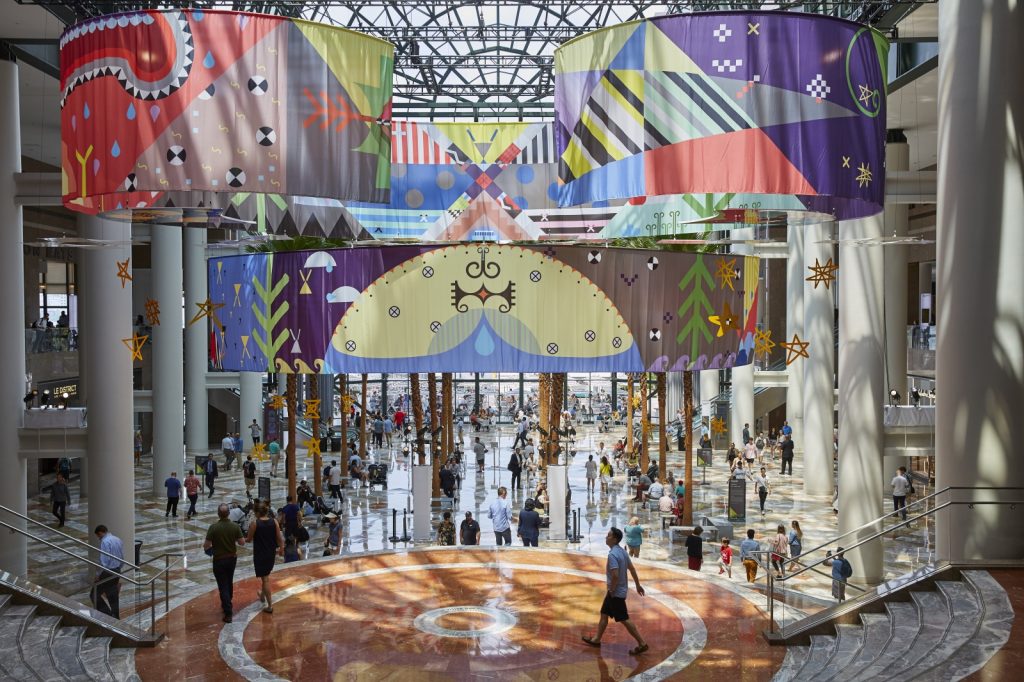
Hollenbach: These are important examples of Indigenous resilience and cultural continuance!
Taunton: Indigenous resilience, and resistance! Settler colonialism has and continues to disrupt and dispossess Indigenous peoples and nations of their lands while also repetitively legitimating itself as rightful owner of the land, its resources, and, in turn, its peoples. The settler imaginary in turn feels entitled to take, to possess, and to claim markers of indigeneity as a component of settler identity. Indigenous artists, knowledge keepers, educators, leaders, and storytellers have made enormous contributions to dismantling these myths.
Hollenbach: Totally. Mi’kmaq artist Ursula Johnson’s performance “The Indian Truckhouse of Fine Art” (2011) works to subvert these projections of settler colonial fantasies about Indigeneity and authenticity. It is a performance in which Johnson exercised her treaty rights to sell her wares. Wearing the traditional dress of 19th century Mi’kmaq women, she set up and tended a stall selling items she found in souvenir shops and discount stores that she deemed to be culturally appropriative. To each of these items she affixed a piece of hand spun and dyed yarn with a tag that read “This object is 100% Authentic Indian High Art. Made in Mi’kma’ki.” On the reverse of each tag, a price between $17.20 to $17.90 was given (these prices reference the dates of the Peace and Friendship Treaties between the Mi’kmaq and the Crown).
Taunton: Yes! I love this work. Ursula Johnson’s “The Indian Truckhouse of Fine Art” subverts the colonial ideology of the salvage paradigm and the outside Eurocentric constructions of hierarchies and classifications that reflect western value systems and the longstanding longing to possess something of the other. The salvage paradigm was a late 19th and early 20th century attempt to collect and preserve Indigenous material culture; to document cultural, social, and political practice; and to create a permanent record based on the Eurocentric belief that Indigenous peoples were vanishing. Although these attitudes shifted in the academic and museological sense, Haida art historian Marcia Crosby argues that much of the Indigenous art produced in the 1980s and 1990s is an attempt to reclaim the image of Indigenous peoples from the ethnographic context of the salvage paradigm. Indigeneity was theoretically and physically collected by settler society: material and visual culture were seen as being salvaged and placed into museum collections, and artists and photographers documented and collected the images of individuals and snap shots of everyday culture.
Today’s salvage paradigm could be seen as cultural appropriation. Colonial legacies remain embedded in Canadian culture, exemplified in the misplaced yet common belief that so-called authentic Indigenous cultures were lost through contact with European society. The result of this feeling of loss in non-Indigenous consciousness was the construction of an expectation of a fixed Indigenous culture—which Indigenous peoples have resisted and subverted throughout the processes of colonization and decolonization.
Hollenbach: The salvage paradigm didn’t function only on an institutional level, with ethnographers collecting Indigenous culture for museums, but also on a personal individual level, with colonial military officers returning home to Britain with souvenirs of Indigenous culture as gifts for their wives and daughters. Those objects would be proudly displayed in the parlour as status symbols. Later, European settlers would collect Indigenous cultural objects and souvenirs for display in their own homes. Often, there’s this perception that colonialism was this masculinist pursuit enacted in the public realm through war and conflict, treaty signing, and border making.
But colonialism also occurred through the domestic practices of white-settler women as they created homes meant to mirror the imperial centre on the empire’s periphery. Algonquin and French-Canadian artist Nadia Myre made a work providing a powerful critique of this history in 2016, called Decolonial Gestures or Doing It Wrong? Refaire le Chemin. The work drew inspiration from Victorian women’s magazines with text descriptions that guided anglophone settler women in the creation of Indigenous inspired handicrafts. Myre followed the instructions, which were read out to her, without knowing beforehand what she was making. The work unravels the violent ongoing colonial action of attempting to consume and homogenize Indigenous culture.
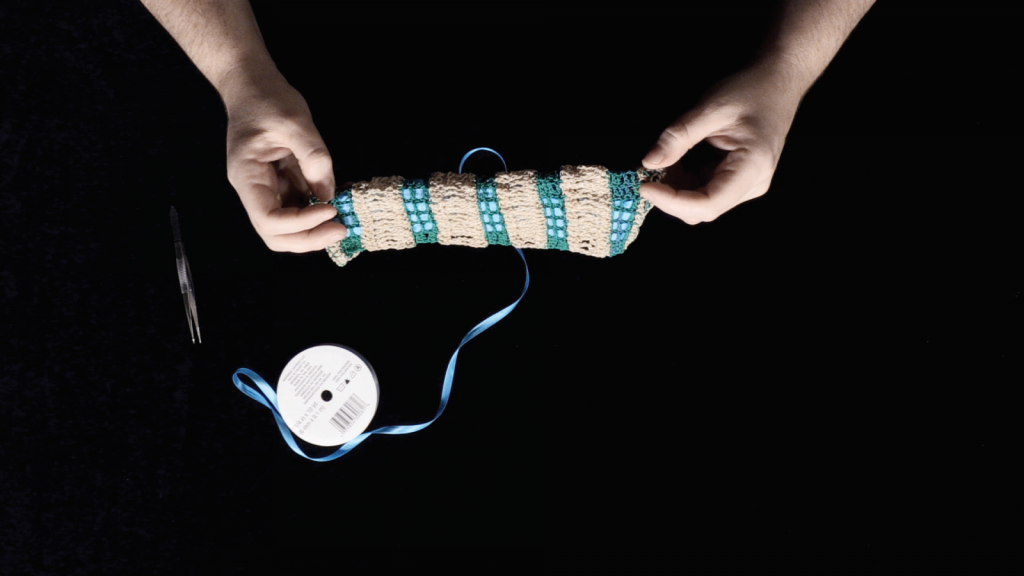
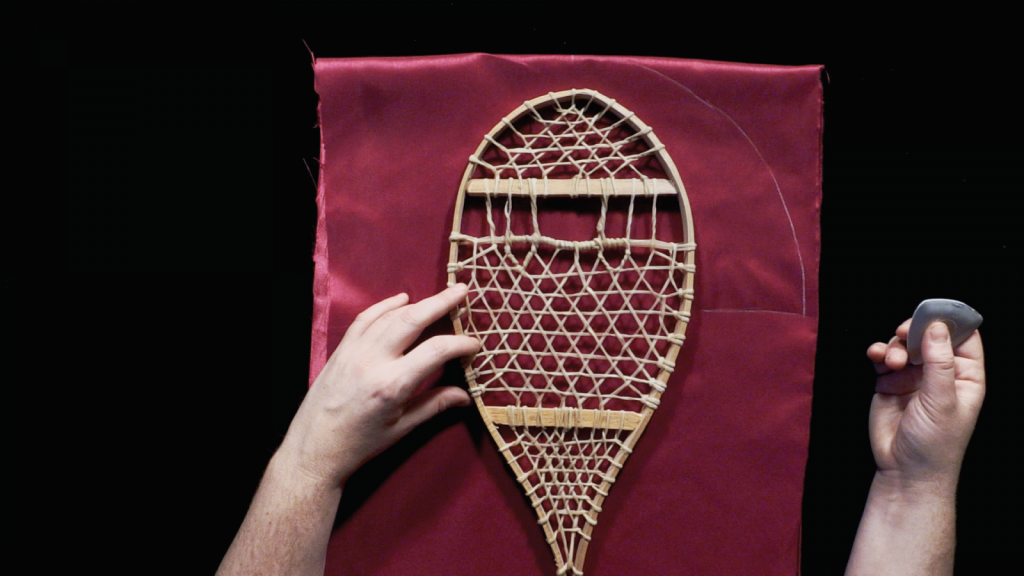
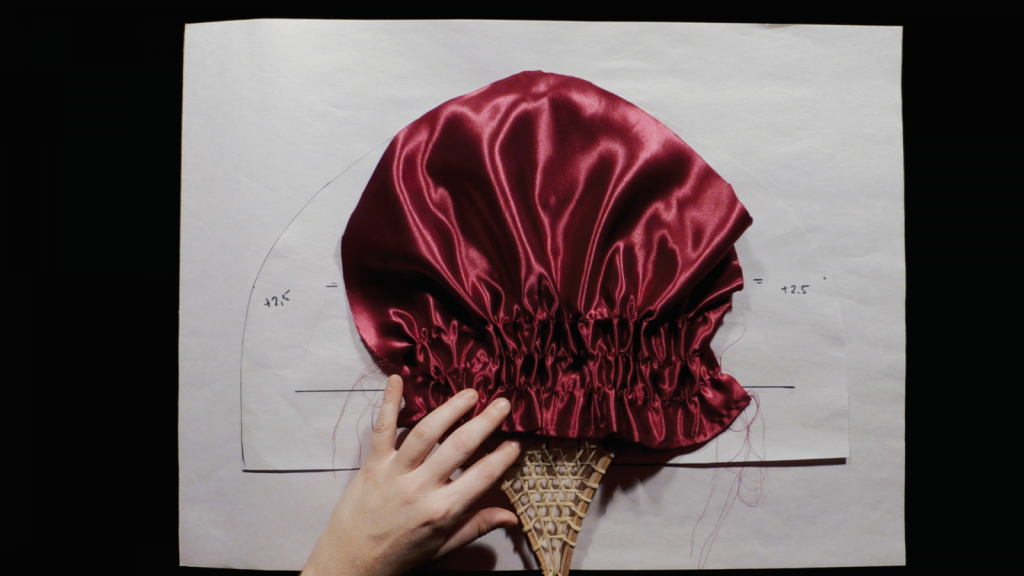
Taunton: Specifically, these objects, which as you note were very important objects within white-settler domestic spaces, in many cases were made by Indigenous women using adaptations and integration of trade materials (such as glass beads, velvet, wool, silk ribbon etc.) with Indigenous iconography and materials. They are important objects of Indigenous continuity, meaning that they are vessels which hold past historical and cultural knowledge as well as familial and collective intergenerational memories.
In Mi’kmaq territory, quill pill boxes, calling card trays, pin cushions, and the backing and seat panels of chairs were actively collected and now are housed in museums such as the Natural History Museum here in Halifax as well as large holdings at the McCord Museum in Montréal among others. Many leading Indigenous thinkers explain this phenomenon as an act of cultural continuance and, in some cases, a practice of resistance during a time of heightened assimilation. So Mi’kmaq makers were creating a new economy to support their families while continuing to pass down knowledge encoded in the designs and making practices. This is all happening against the backdrop of the very aggressive assimilationist policies of cultural genocide established by the federal government and enacted through the Indian Act, such as the forced removal of children to Residential Schools and the ceremonial or potlach ban 1884-1951, which deemed ceremonies and cultural customary practices and objects illegal.
Hollenbach: A lot of these confiscated and stolen objects were placed in provincial and federal museums for “safekeeping” and “posterity.” I see a real connection between the display practices of the museum as the state’s showroom of what the nation values—its core beliefs, outlook, and worldviews—and the displays in individual settler’s living rooms, where they proudly present handmade and mass-produced objects that signify the individual or family’s values, beliefs, and investments. Whether that’s inherited family heirlooms, personal creative projects, sports paraphernalia, spiritual icons, luxury items, souvenirs, or Indigenous-made objects, they are either presented as authentic “artifacts” or as strictly aesthetic objects.
Which goes back to that extractive and possessive colonial impulse. When we go to museums, we see stolen objects presented in a static, possessive way that is normalized. And then settlers visit museums and often take on the ideologies and values presented in the space, but also internalize the display logics of the space along with that attitude of entitlement that we talked about. The museum and other key state institutions tell us that it’s normal to collect and display objects for safekeeping for the future. (As if that’s white people’s role!) And so then the individual mirrors this attitude and activity in their own daily life and domestic space. I’ve noticed that within popular public discourse around cultural appropriation there’s an emphasis on the theft of Indigenous culture by museums, or cultural appropriation by sports teams and corporations for their branding, or the way non-Indigenous luxury fashion lines use and misuse Indigenous designs or symbols to sell fast fashion.
Carla: Yes, such as Urban Outfitters’ Navajo co-opted designs, the Canadian teams’ HBC 2010 Olympic Games–inspired Cowichan sweater, Victoria’s Secret’s use of Plains headdresses, Dsquared2’s copy of Inuit and other Indigenous cultural patterns, designs, and garments, and the list goes on and on.
Julie: These examples are harmful in many ways! Cultural appropriation of Indigenous culture and knowledge negates Indigenous sovereignty over their culture, it extracts profit without any kind of return. Indigenous people are not able to determine and control the representation of themselves and their culture, and the stereotypes and misrepresentations often perpetuate the dehumanization of Indigenous people and lead to further violence. I think consumers have an awareness of how big institutions and corporations are perpetrating harm against Indigenous communities, but there seems to be a disconnect or some cognitive dissonance when it comes to translating this understanding to individual consumer practices. I mean, it was and remains a constant practice of unlearning, for me, too—to recognize how individual consumer practices mirror those attitudes of entitlement, extraction, and possession that continue and contribute to present day colonialism.
Taunton: Decolonization is an ongoing process, and unlearning (also ongoing) is key. So many BIPOC artists, curators, and educators have brought these urgent critiques and truths forward. What I find particularly exciting right now are recent collaborations between companies and Indigenous artists, such as Christi Belcourt and Valentino (dresses and purses) or Jordan Bennett and Pendleton Blankets. Also interesting is the recent Indigenous Fashion Week Toronto and Simons collaboration, featuring 8 Indigenous artists’ designs on over 35 garments. These collaborations are Indigenous led and show a way forward that is grounded in ethics of decolonial reciprocity and shared responsibility.
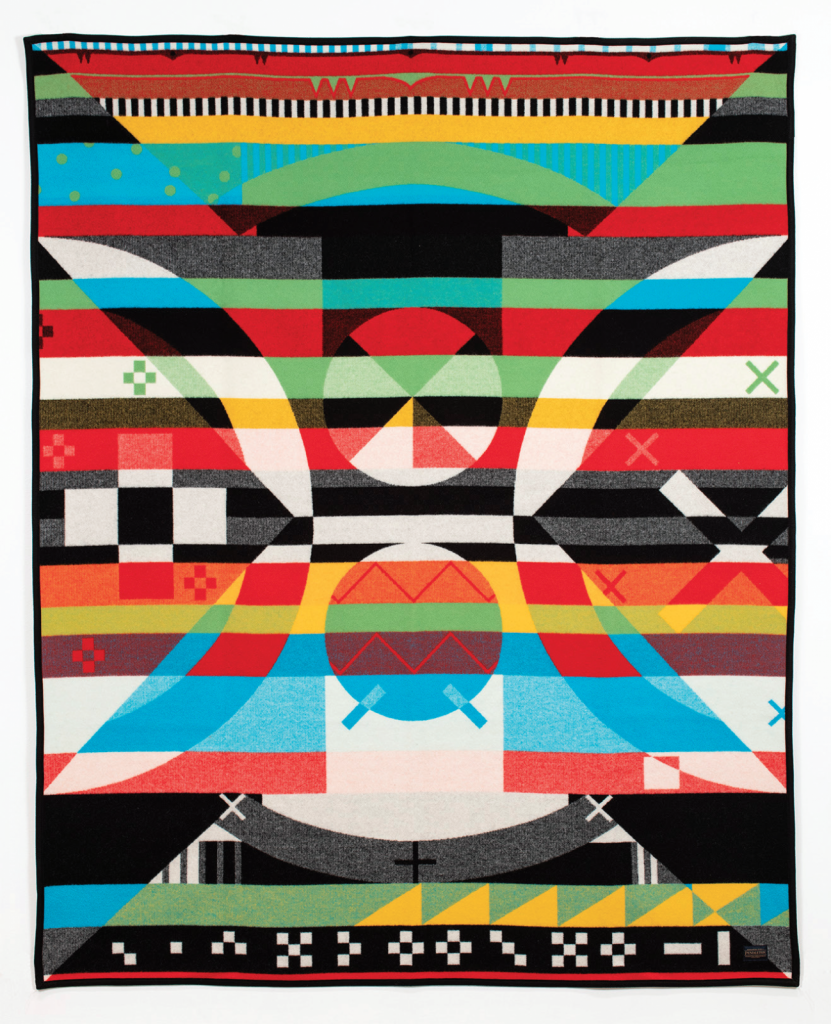
Hollenbach: Yes, exactly. So great! This brings up an important question. In thinking about Indigenous fashion, or Indigenous artists collaborating with popular brands, or Indigenous makers selling jewellery on Etsy, I often hear this question from white-settlers who are trying to engage with Indigenous culture respectfully—it’s also something I remember wondering myself: is it appropriate for settlers to buy and wear Indigenous-made jewellery and fashion, or to buy Indigenous art and live with it in their homes. What are your thoughts?
Taunton: I think it can be a key component to settler responsibility; however, for white settlers it’s imperative to ask the why questions. Is it a desire to participate in what we have explained to be as a colonial longing to own and to know? Meaning, are settlers buying Indigenous jewellery, art, and fashion to consume and co-opt for themselves some aspect of imagined notions of authentic Indigeneity, or can this transaction be situated in self-reflexivity, respectful engagement, and decolonial reciprocity? I think a lot about treaty and treaty relationships and what they could look like in 2020. Here in Mi’kma’ki, the Peace and Friendship Treaties signed in the 1700s were established to create co-existence for Indigenous and non-Indigenous people. To me, the support of Indigenous art and artists is part of all cultural institutions’ treaty responsibilities, generally speaking: purchasing art and crafts from Indigenous artists is an incredibly productive way to contribute to a stronger arts community. Currently there are many Mi’kmaq and Inuk artists on Instagram and Etsy who are making absolutely brilliant work, such as Melissa Peter Paul, Nicole Traverse (Blomindon Beadwork), and Mi’kmaq Printing, Inez Shiwak, and Vanessa Flowers among others.
Hollenbach: Yes. Looking to treaty as a guide here is so helpful. Can you expand on this?
Taunton: Living in Mi’kma’ki, we have an existing roadmap to co-existence by looking to and learning about the Peace and Friendship Treaties. These treaties show us how to move towards activating a nation to nation relationship and reciprocal responsibilities. The treaties are based on Indigenous Mi’kmaq practices and principles of shared accountability, shared respect, and friendship. And there is an expectation of living together in peace, but also of reciprocity. It’s rooted in Indigenous sovereignty, and it invites all folks who are non-indigenous—to include Black people and people of Colour, recent arrivals, and white-settlers, too—to participate in treaty-making every day. To aim to make treaty everyday can help guide us as a community of Indigenous, Black, POC and white-settlers in asking questions about stewardship, about what we purchase and how we engage with the lands we live and work on. To embody treaty for settlers means to navigate the everyday to include art making, curatorial practice, and other cultural work in a way that upholds principles of accountability and reciprocity. It also means to commit to learning and unlearning while disrupting and dismantling patterns of colonial harm, co-option, and, ultimately, possession.

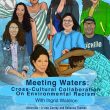
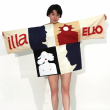













Thank you for this piece from 2 years ago.
I’m curious what the authors’ definition of decolonial is.
I look at an argument like this and am rather baffled: “Meaning, are settlers buying Indigenous jewellery, art, and fashion to consume and co-opt for themselves some aspect of imagined notions of authentic Indigeneity, or can this transaction be situated in self-reflexivity, respectful engagement, and decolonial reciprocity?”
One cannot choose what an exchange–that is, a purchase–means. That meaning is structurally inherent in the exchange relation in capital. The abstraction that occurs–that transformation of a product of labour into a commodity and all that that entails–cannot be wished away by good intention.
As Yellowknives Dene scholar Glenn Sean Coulthard argues in “Red Skin, White Masks”, colonialasm–what he calls the “colonial relation”–incorporates what he, following Marx, calls the “capital relation”; as much as the former is more than the capital relation, the latter cannot be selectively removed from the former. There is no purchase, to put it bluntly, that is decolonial.
Yes, there can be purchases that “support” Indigenous makers, but let’s not call it decolonial. Let’s call this sort of gesture–the purchase of Indigenous art– what it is: liberal and in many ways assimilationist.